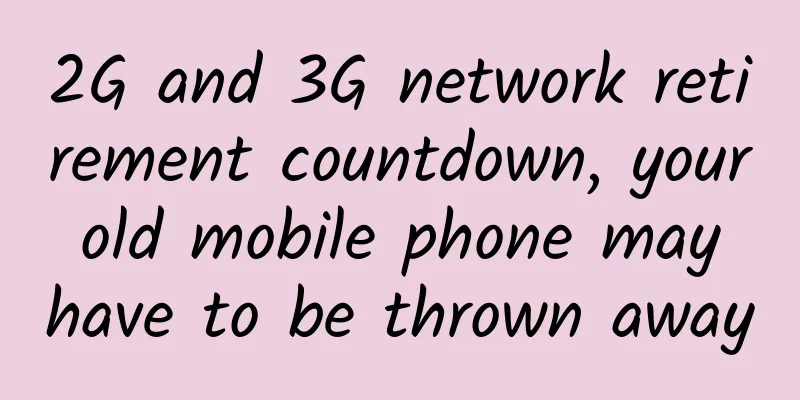2G and 3G network retirement countdown, your old mobile phone may have to be thrown away

|
This also means that 2G and 3G technologies will no longer be developed, marking the end of an important era in the mobile communications industry.
2G and 3G are about to exit the stage of history As early as October 2019, at a press conference held by the State Council Information Office, Wen Ku, Director of the Information and Communications Development Department of the Ministry of Industry and Information Technology, stated that the withdrawal of 2G and 3G networks is an inevitable choice for the renewal of mobile communications, and is also the main practice of various countries in the world. During this year's two sessions, Zhang Yunyong, member of the National Committee of the Chinese People's Political Consultative Conference and general manager of China Unicom's product center, also proposed a proposal on "orderly promoting the withdrawal of obsolete 2G network capacity". He pointed out that when the mobile communication network is upgraded, it is necessary to strictly control the increase in 2G users and orderly reduce the stock of 2G users, help operators continuously reduce operating costs, gradually eliminate obsolete production capacity, and effectively reduce the burden on operators, so that operators have more energy and resources to focus on promoting the high-quality development of 5G. In May this year, the General Office of the Ministry of Industry and Information Technology issued the "Notice on Deepening the Comprehensive Development of Mobile Internet of Things", which for the first time clearly guided new IoT terminals to no longer use 2G/3G networks, and promoted the migration of existing 2G/3G IoT services to NB-IoT/4G (Cat1)/5G networks. Many signs indicate that the exit of 2G/3G networks from the historical stage is an inevitable choice. 2G The second generation of cellular technology, 2G, also known as GSM (Global System for Mobile Communications), was the first digital era and the first global cellular communication network with universal standards developed by ETSI and adopted by almost every country. The main features of 2G are:
As time goes by, a new bearer service, GPRS, has been developed on the GSM system to provide GSM users with packet data services. GPRS is a transitional industry from 2G to 3G. In theory, the maximum transmission speed that can be achieved through GPRS is about 170 Kbps. 3G With the accelerated popularization of the Internet and the data transmission limitations of 2G, the third generation mobile communication technology 3G was successfully launched in 2000. UMTS (Universal Mobile Telecommunications Service) is a complete 3G mobile communication technology standard. The main features of 3G are:
4G As the Internet continues to develop, smartphones and their application ecosystems have also arrived, and the demand for higher data rates in mobile networks has continued to grow. This has directly promoted the birth of 4G (also known as LTE, Long Term Evolution), which currently supports most of our mobile data traffic. Its main features are:
The upcoming 5G will bring higher efficiency, faster data rates, and enhanced services. Currently, all digital technologies coexist. However, this will soon end, and in the coming years, we will witness the disappearance of 2G and 3G networks. 2G/3G network withdrawal, the benefits outweigh the disadvantages Wireless communication technology has been evolving from generation to generation, and has now entered the 5G era. The 2G/3G networks that once made great contributions to operators have now become a burden to operators to a large extent, waiting to be retired. First, if operators maintain 2G/3G/4G/5G at the same time, it will inevitably greatly increase the difficulty of network operation and maintenance and increase the network construction cost of operators; secondly, 2G/3G network equipment and technology are outdated and consume a lot of power, which is difficult to meet the requirements of current low-carbon and energy-saving networks; thirdly, 2G/3G uses a lot of golden spectrum resources with low utilization efficiency. These precious resources can be released for new technologies and new services such as 5G. It is reported that the three major operators have reached a consensus on the frequency adjustment plan for the 900MHz, 1900MHz and 2600MHz bands. Some issues that need attention when decommissioning 2G/3G network Although the withdrawal of 2G/3G networks is inevitable, it may also bring some impacts: 1. Coverage: The withdrawal of 2G/3G networks may result in a smaller network coverage. Users who originally used 2G/3G networks will lose services, and telecom operators will also lose the revenue brought by these users. 2. Equipment/Technology: Some current equipment and supported technologies will also be affected. For example, M2M (machine-to-machine) equipment mainly relies on 2G networks. These devices are difficult to migrate to new technologies, so many operators may choose to continue to maintain 2G networks in areas where they deploy M2M service infrastructure in the future. 3. Voice services: Telecom operators usually need to maintain traditional 2G/3G networks to support voice services. Although VoLTE (LTE-4G voice) technology currently provides a more effective voice service solution than 2G/3G technology, VoLTE is still unavailable on a considerable portion of 4G networks (approximately 25-30% of the networks have not yet been launched or are in the initial stages of deployment). Delisting progress According to data from the Ministry of Industry and Information Technology, as of the end of May this year, the total number of mobile phone users of the three major operators reached 1.592 billion, of which 4G users were 1.279 billion. Data from operators during the same period showed that there were about 100 million 5G users in China. In other words, there are still about 200 million 2G and 3G users in China. Once 2G and 3G are decommissioned, 2G and 3G mobile phones may not be able to be used completely normally and need to be upgraded to 4G or 5G mobile phones. At present, the three major operators have successively launched the 2G/3G network withdrawal plan. China Unicom announced as early as 2018 that it would orderly promote the withdrawal of 2G frequency reduction; China Telecom clearly stated at the end of 2019 that 5G terminals are not allowed to have CDMA mode, and from June 1 this year, it will gradually shut down the 3G network in Yunnan. China Mobile's actions speak louder than words, and its 3G standard has basically completed the withdrawal of the network. The revenue generated by 2G and 3G networks is increasingly out of line with the cost and resource requirements, and network withdrawal is an inevitable trend. The three major operators have huge network scales, and for various reasons, they have not given a clear timetable for network withdrawal, but they are already on the road to network withdrawal. |
>>: Interviewer asked: Tell me about the principle of IP address allocation
Recommend
[6.18] CMIVPS recharge gift 20%, Hong Kong high bandwidth VPS monthly payment 20% off / annual payment 30% off
CMIVPS has launched a special promotion for 6.18....
RackNerd Easter promotion starts at $10.78/year, multiple data centers in Seattle/New York/Dallas, etc.
I just shared the summary of RackNerd's histo...
Telling the story of HTTPS
Starring in the story: Xiaohua is a freshman this...
How to prevent 5G from creating a new digital divide
There is no doubt that more pervasive 5G technolo...
I've been waiting for 10 years for the technology that allows me to surf the Internet on airplanes. Where does it come from?
In the past, when we were on an airplane, the fli...
LOCVPS New Year Promotion: Netherlands VPS 40% off, starting from 22 yuan, Singapore VPS/Russia VPS/Hong Kong VPS 30% off
LOCVPS (Global Cloud) is a long-established Chine...
Tudcloud: Hong Kong VPS 30% off, starting from $7.2/month, with options for high bandwidth or unlimited traffic
Tudcloud has sent out the latest promotion, with ...
V.PS: €9.95/year VPS with new German data center, 1G memory/15G SSD/1TB monthly traffic
The Nano series provided by V.PS adds a German da...
How to Choose and Buy Network Automation Tools
The concept of network automation has been around...
Let's talk about short links
Introduction I am working on a promotion system r...
The 5G era is coming soon. If you don’t answer these 10 questions, you will be left behind.
Ultra-fast "fifth-generation 5G" mobile...
How to choose an API management platform for your business
【51CTO.com Quick Translation】As we all know, API ...
80VPS: Hong Kong/Japan/Korea/USA 1-16C cluster server starting from 800 yuan/month
A friend talked about cluster servers. I recently...
Performance Agreement: API Rate Limit
Rate limiting is a key control mechanism used to ...









